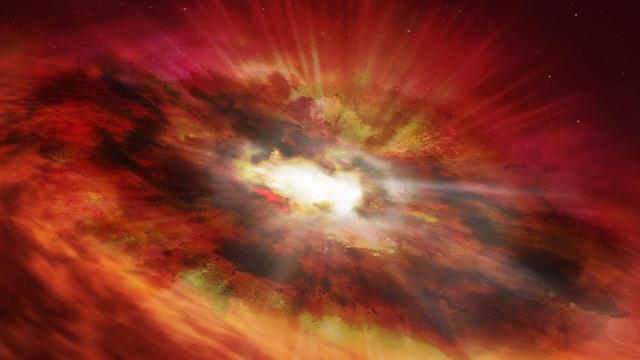A team of researchers poring over archival data from the Hubble Space Telescope found an ancient object they believe may explain how quasars — supermassive black holes surrounded by jet-spewing discs of matter — emerge from dusty “starburst” galaxies.
The vast object is called GNz7q, and it existed when the universe was just 750 million years old, about 13 billion years ago. GNz7q is shrouded in dust, so researchers still aren’t sure what it is. But based on current theories of black hole formation, and the sheer size of the object, the astronomers believe GNz7q is the precursor to a supermassive black hole. Their research is published this week in Nature.
How the first black hole in the universe formed is “still one of the largest unknowns,” said study author Seiji Fujimoto, an astronomer at the Niels Bohr Institute of the University of Copenhagen in Denmark, in an email to Gizmodo. One common theory, he said, is that the first black hole emerged from the first dead stars and swiftly swallowed up surrounding material. Another idea is that gas in the early universe collapsed, directly producing a black hole without an intermediate stellar period.
“Our study cannot answer which scenario is more likely this time, but at least our discovery suggests the first example of a rapidly growing black hole in the earliest epoch of the universe,” Fujimoto said.
GNz7q sits in a galaxy called a “starburst” for the rapid proliferation of stars within it; the galaxy is producing about 1,600 solar masses worth of stars per year. GNz7q is about 20 billion solar masses worth of gas, and the black hole the team suspects lurks within the dusty disk is 10 million solar masses (meaning 10 million times the mass of our Sun).
Fujimoto’s team thinks the black hole inside GNz7q is the missing link between the dusty starburst galaxies and the massive, luminous quasars that pepper our universe today. Quasars are very bright and dense galactic cores that emit lots of radiation and are powered by supermassive black holes at their centres.
“This is a unique object, different from the handful of other quasars and galaxies found at similarly early stages of the universe,” said Zoltan Haiman, an astrophysicist at Columbia University who is unaffiliated with the new paper, in an email to Gizmodo.
GNz7q is reddened by the dust that enshrouds it and appears very bright in infrared wavelengths. “The features they find also fit well with the idea that the most massive, billion-solar mass black holes at this epoch had an earlier stage, in which they grew very rapidly, surrounded by a galaxy that is forming stars also extremely rapidly, and gas and dust which enshrouds the central regions and makes the colours appear very red,” Haiman added.
Fujimoto’s team hopes that the Webb Space Telescope — which will observe some of the oldest light in the universe in the infrared and near-infrared wavelengths — will greatly improve the detail with which astronomers can observe objects like GNz7q.
GNz7q was sitting in a part of the sky that is well studied, yet its presence was only just reported. “They either lucked out, or these progenitor objects are much more common than we had thought,” Haiman said.
More: The World’s Largest Digital Camera Is Almost Ready to Look Back in Time
